Astronomy Assignment: A Deep Dive into Celestial Bodies and Phenomena
VerifiedAdded on 2020/04/01
|7
|1495
|258
Homework Assignment
AI Summary
This astronomy assignment provides detailed explanations of various celestial phenomena and planetary characteristics. It explores concepts such as the ecliptic, seasons, lunar eclipses, and the Earth's internal structure, including the evidence supporting a metallic core. The assignment also delves into the greenhouse effect on Earth and Venus, comparing their atmospheric conditions and resulting temperatures. Furthermore, it examines volcanic activity on Mars and Venus, discussing the types of lava and volcanoes found on these planets. The document then analyzes evidence of water on Mars, the energy emissions of Jupiter and Saturn, the oblateness of these gas giants, the composition of Saturn's F ring, and the bluish color of Neptune. References to relevant research papers are also included.
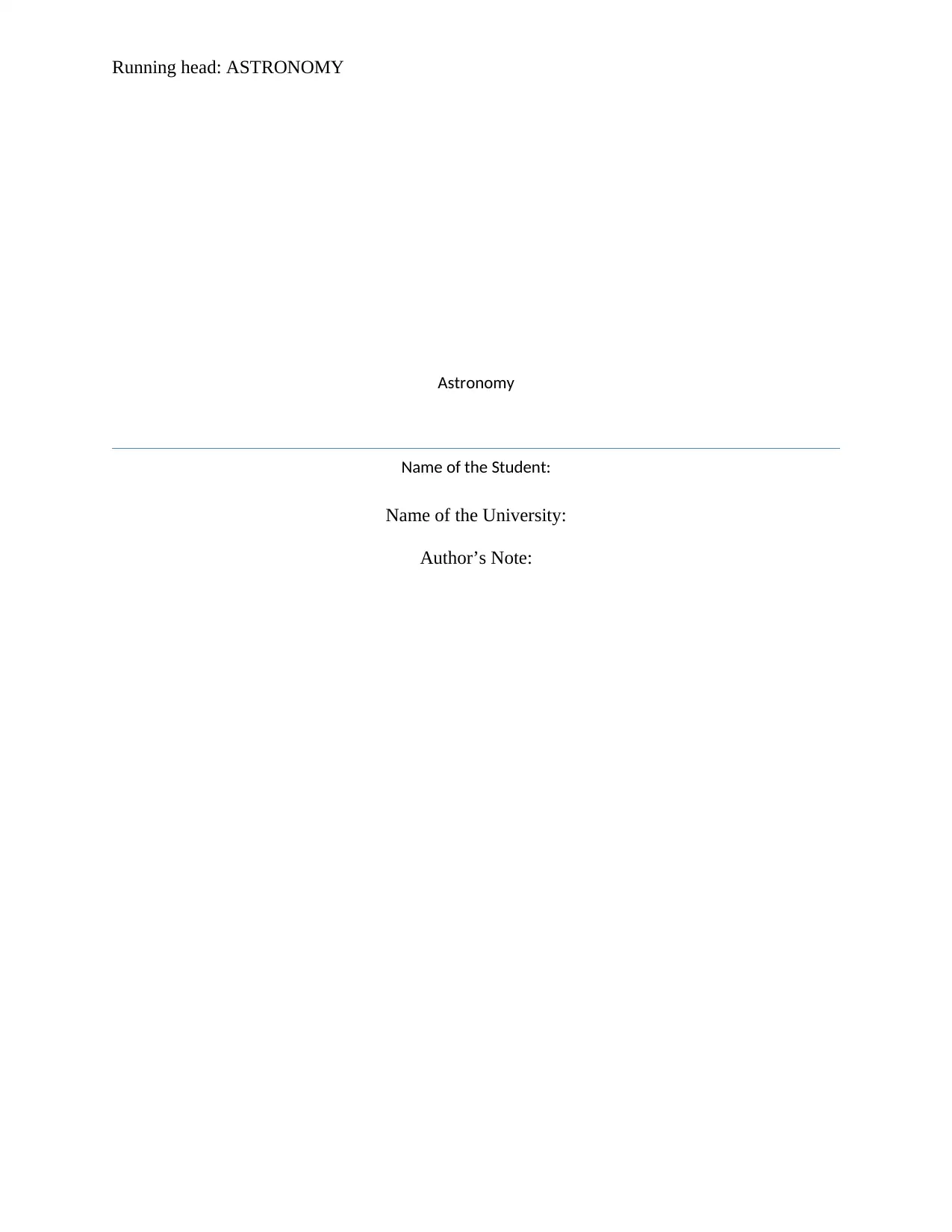
Running head: ASTRONOMY
Astronomy
Name of the Student:
Name of the University:
Author’s Note:
Astronomy
Name of the Student:
Name of the University:
Author’s Note:
Paraphrase This Document
Need a fresh take? Get an instant paraphrase of this document with our AI Paraphraser

2ASTRONOMY
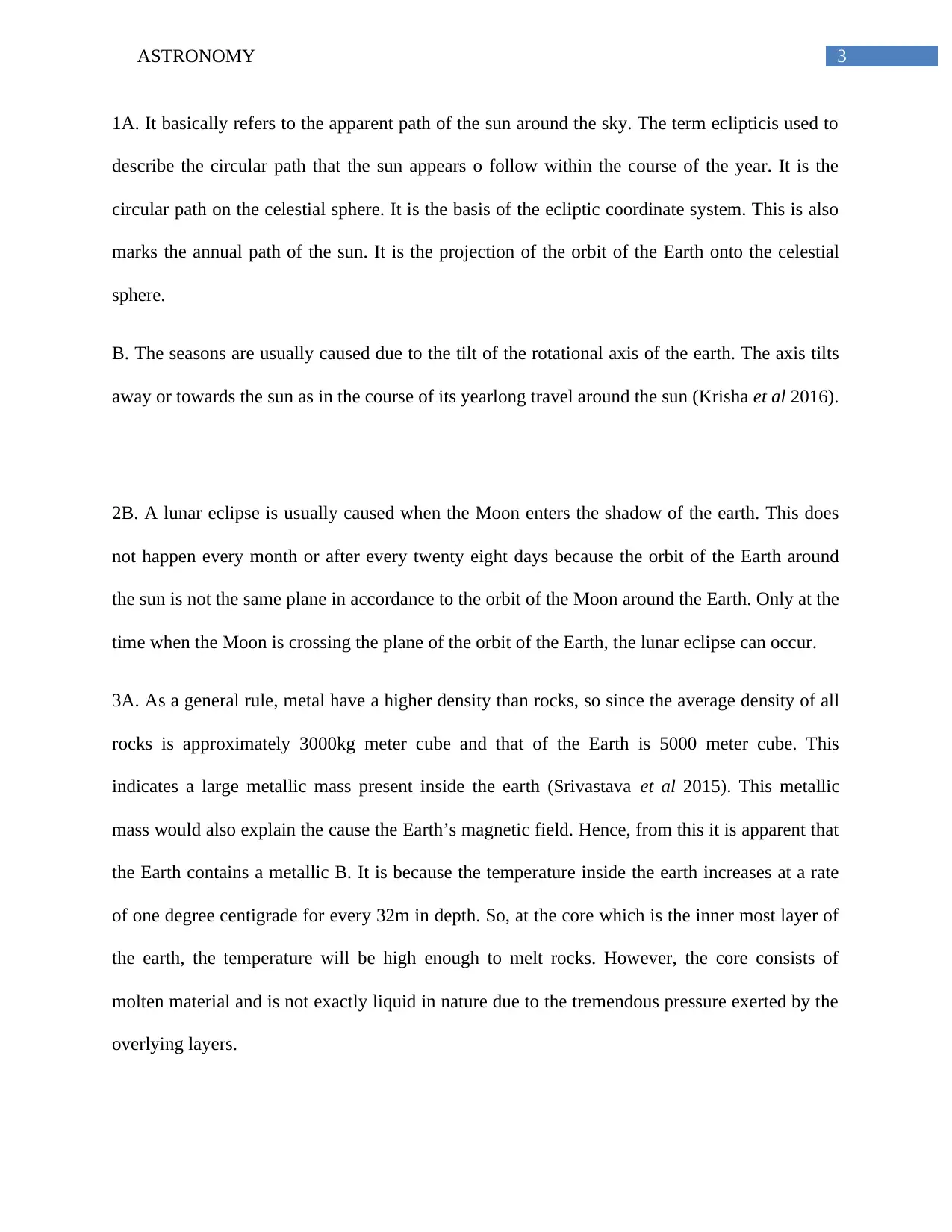
3ASTRONOMY
1A. It basically refers to the apparent path of the sun around the sky. The term eclipticis used to
describe the circular path that the sun appears o follow within the course of the year. It is the
circular path on the celestial sphere. It is the basis of the ecliptic coordinate system. This is also
marks the annual path of the sun. It is the projection of the orbit of the Earth onto the celestial
sphere.
B. The seasons are usually caused due to the tilt of the rotational axis of the earth. The axis tilts
away or towards the sun as in the course of its yearlong travel around the sun (Krisha et al 2016).
2B. A lunar eclipse is usually caused when the Moon enters the shadow of the earth. This does
not happen every month or after every twenty eight days because the orbit of the Earth around
the sun is not the same plane in accordance to the orbit of the Moon around the Earth. Only at the
time when the Moon is crossing the plane of the orbit of the Earth, the lunar eclipse can occur.
3A. As a general rule, metal have a higher density than rocks, so since the average density of all
rocks is approximately 3000kg meter cube and that of the Earth is 5000 meter cube. This
indicates a large metallic mass present inside the earth (Srivastava et al 2015). This metallic
mass would also explain the cause the Earth’s magnetic field. Hence, from this it is apparent that
the Earth contains a metallic B. It is because the temperature inside the earth increases at a rate
of one degree centigrade for every 32m in depth. So, at the core which is the inner most layer of
the earth, the temperature will be high enough to melt rocks. However, the core consists of
molten material and is not exactly liquid in nature due to the tremendous pressure exerted by the
overlying layers.
1A. It basically refers to the apparent path of the sun around the sky. The term eclipticis used to
describe the circular path that the sun appears o follow within the course of the year. It is the
circular path on the celestial sphere. It is the basis of the ecliptic coordinate system. This is also
marks the annual path of the sun. It is the projection of the orbit of the Earth onto the celestial
sphere.
B. The seasons are usually caused due to the tilt of the rotational axis of the earth. The axis tilts
away or towards the sun as in the course of its yearlong travel around the sun (Krisha et al 2016).
2B. A lunar eclipse is usually caused when the Moon enters the shadow of the earth. This does
not happen every month or after every twenty eight days because the orbit of the Earth around
the sun is not the same plane in accordance to the orbit of the Moon around the Earth. Only at the
time when the Moon is crossing the plane of the orbit of the Earth, the lunar eclipse can occur.
3A. As a general rule, metal have a higher density than rocks, so since the average density of all
rocks is approximately 3000kg meter cube and that of the Earth is 5000 meter cube. This
indicates a large metallic mass present inside the earth (Srivastava et al 2015). This metallic
mass would also explain the cause the Earth’s magnetic field. Hence, from this it is apparent that
the Earth contains a metallic B. It is because the temperature inside the earth increases at a rate
of one degree centigrade for every 32m in depth. So, at the core which is the inner most layer of
the earth, the temperature will be high enough to melt rocks. However, the core consists of
molten material and is not exactly liquid in nature due to the tremendous pressure exerted by the
overlying layers.
⊘ This is a preview!⊘
Do you want full access?
Subscribe today to unlock all pages.

Trusted by 1+ million students worldwide
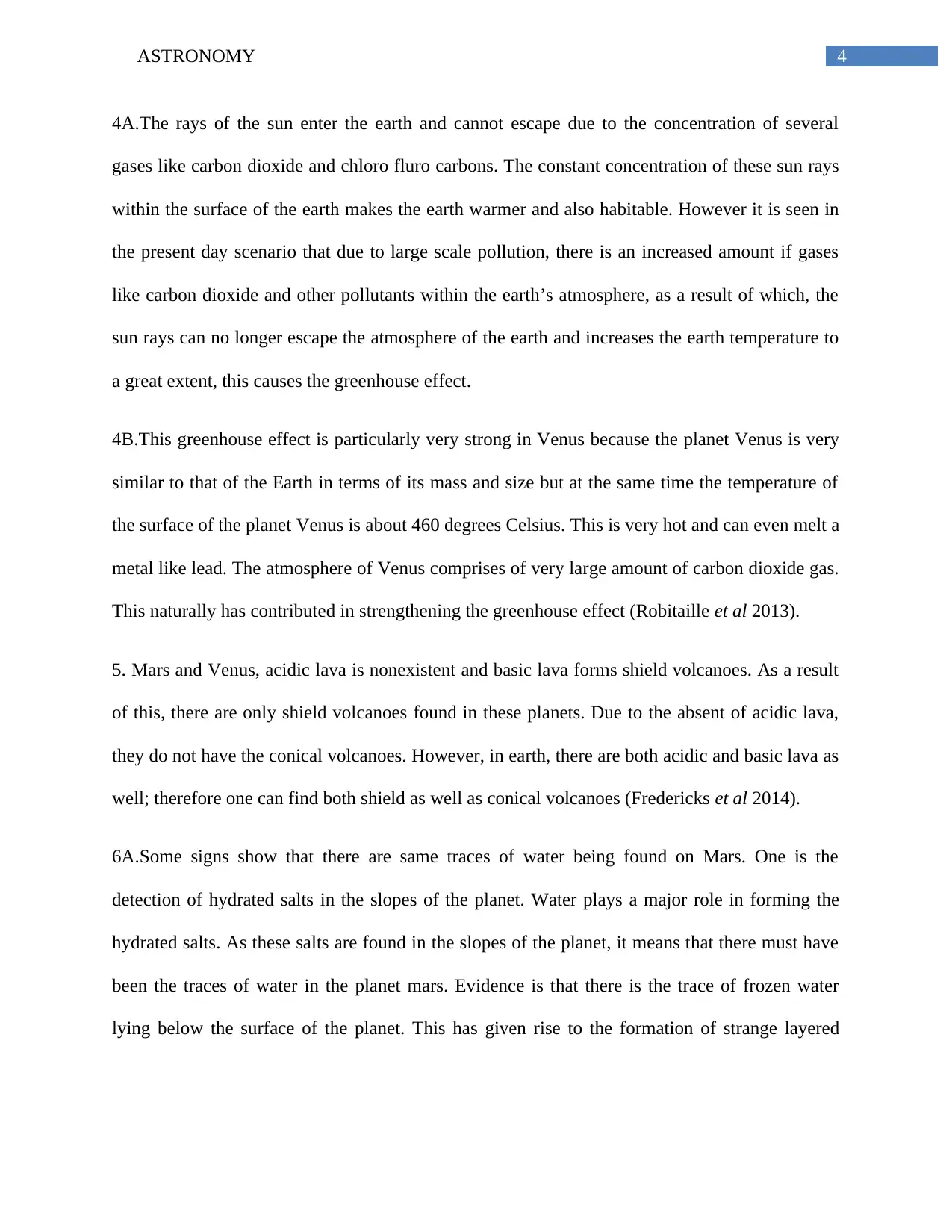
4ASTRONOMY
4A.The rays of the sun enter the earth and cannot escape due to the concentration of several
gases like carbon dioxide and chloro fluro carbons. The constant concentration of these sun rays
within the surface of the earth makes the earth warmer and also habitable. However it is seen in
the present day scenario that due to large scale pollution, there is an increased amount if gases
like carbon dioxide and other pollutants within the earth’s atmosphere, as a result of which, the
sun rays can no longer escape the atmosphere of the earth and increases the earth temperature to
a great extent, this causes the greenhouse effect.
4B.This greenhouse effect is particularly very strong in Venus because the planet Venus is very
similar to that of the Earth in terms of its mass and size but at the same time the temperature of
the surface of the planet Venus is about 460 degrees Celsius. This is very hot and can even melt a
metal like lead. The atmosphere of Venus comprises of very large amount of carbon dioxide gas.
This naturally has contributed in strengthening the greenhouse effect (Robitaille et al 2013).
5. Mars and Venus, acidic lava is nonexistent and basic lava forms shield volcanoes. As a result
of this, there are only shield volcanoes found in these planets. Due to the absent of acidic lava,
they do not have the conical volcanoes. However, in earth, there are both acidic and basic lava as
well; therefore one can find both shield as well as conical volcanoes (Fredericks et al 2014).
6A.Some signs show that there are same traces of water being found on Mars. One is the
detection of hydrated salts in the slopes of the planet. Water plays a major role in forming the
hydrated salts. As these salts are found in the slopes of the planet, it means that there must have
been the traces of water in the planet mars. Evidence is that there is the trace of frozen water
lying below the surface of the planet. This has given rise to the formation of strange layered
4A.The rays of the sun enter the earth and cannot escape due to the concentration of several
gases like carbon dioxide and chloro fluro carbons. The constant concentration of these sun rays
within the surface of the earth makes the earth warmer and also habitable. However it is seen in
the present day scenario that due to large scale pollution, there is an increased amount if gases
like carbon dioxide and other pollutants within the earth’s atmosphere, as a result of which, the
sun rays can no longer escape the atmosphere of the earth and increases the earth temperature to
a great extent, this causes the greenhouse effect.
4B.This greenhouse effect is particularly very strong in Venus because the planet Venus is very
similar to that of the Earth in terms of its mass and size but at the same time the temperature of
the surface of the planet Venus is about 460 degrees Celsius. This is very hot and can even melt a
metal like lead. The atmosphere of Venus comprises of very large amount of carbon dioxide gas.
This naturally has contributed in strengthening the greenhouse effect (Robitaille et al 2013).
5. Mars and Venus, acidic lava is nonexistent and basic lava forms shield volcanoes. As a result
of this, there are only shield volcanoes found in these planets. Due to the absent of acidic lava,
they do not have the conical volcanoes. However, in earth, there are both acidic and basic lava as
well; therefore one can find both shield as well as conical volcanoes (Fredericks et al 2014).
6A.Some signs show that there are same traces of water being found on Mars. One is the
detection of hydrated salts in the slopes of the planet. Water plays a major role in forming the
hydrated salts. As these salts are found in the slopes of the planet, it means that there must have
been the traces of water in the planet mars. Evidence is that there is the trace of frozen water
lying below the surface of the planet. This has given rise to the formation of strange layered
Paraphrase This Document
Need a fresh take? Get an instant paraphrase of this document with our AI Paraphraser
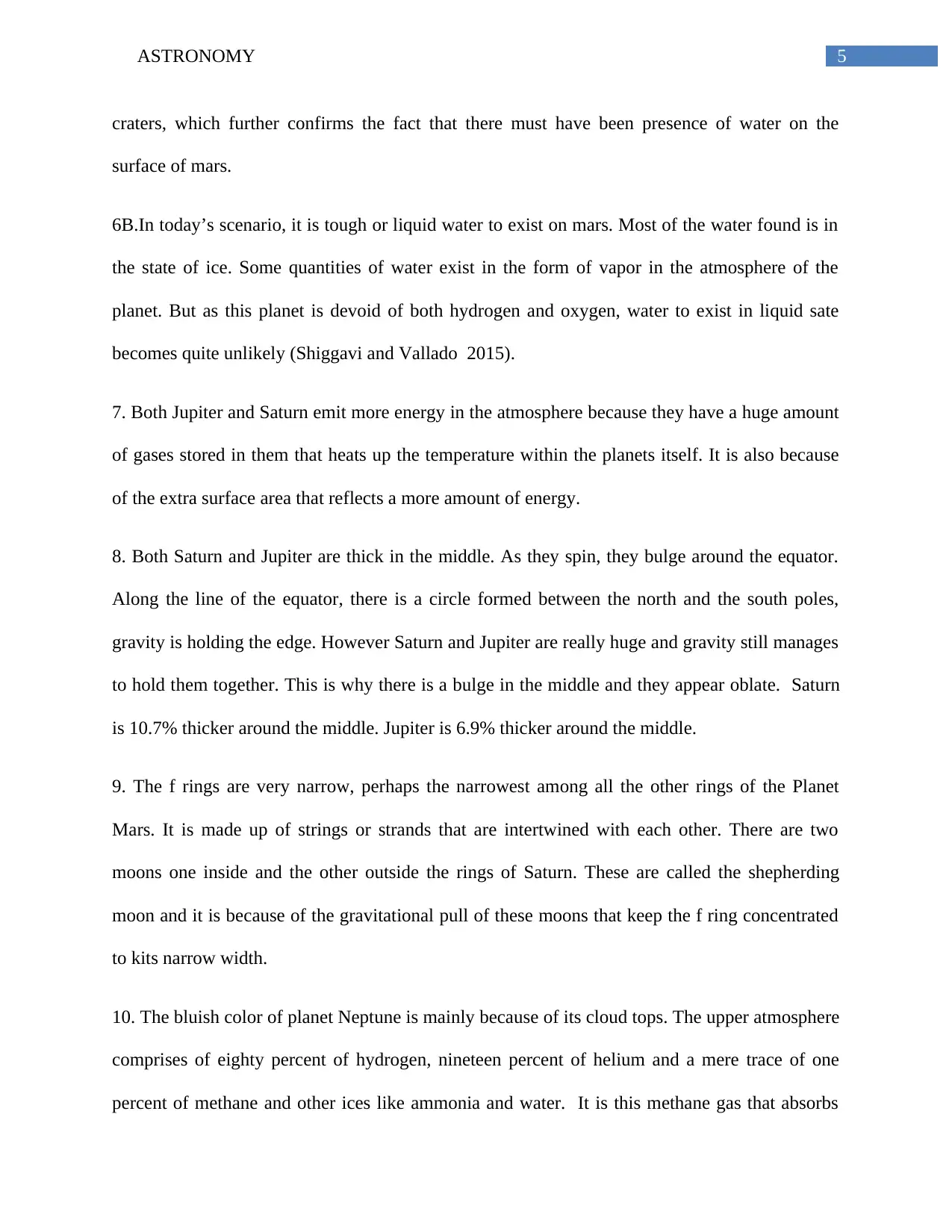
5ASTRONOMY
craters, which further confirms the fact that there must have been presence of water on the
surface of mars.
6B.In today’s scenario, it is tough or liquid water to exist on mars. Most of the water found is in
the state of ice. Some quantities of water exist in the form of vapor in the atmosphere of the
planet. But as this planet is devoid of both hydrogen and oxygen, water to exist in liquid sate
becomes quite unlikely (Shiggavi and Vallado 2015).
7. Both Jupiter and Saturn emit more energy in the atmosphere because they have a huge amount
of gases stored in them that heats up the temperature within the planets itself. It is also because
of the extra surface area that reflects a more amount of energy.
8. Both Saturn and Jupiter are thick in the middle. As they spin, they bulge around the equator.
Along the line of the equator, there is a circle formed between the north and the south poles,
gravity is holding the edge. However Saturn and Jupiter are really huge and gravity still manages
to hold them together. This is why there is a bulge in the middle and they appear oblate. Saturn
is 10.7% thicker around the middle. Jupiter is 6.9% thicker around the middle.
9. The f rings are very narrow, perhaps the narrowest among all the other rings of the Planet
Mars. It is made up of strings or strands that are intertwined with each other. There are two
moons one inside and the other outside the rings of Saturn. These are called the shepherding
moon and it is because of the gravitational pull of these moons that keep the f ring concentrated
to kits narrow width.
10. The bluish color of planet Neptune is mainly because of its cloud tops. The upper atmosphere
comprises of eighty percent of hydrogen, nineteen percent of helium and a mere trace of one
percent of methane and other ices like ammonia and water. It is this methane gas that absorbs
craters, which further confirms the fact that there must have been presence of water on the
surface of mars.
6B.In today’s scenario, it is tough or liquid water to exist on mars. Most of the water found is in
the state of ice. Some quantities of water exist in the form of vapor in the atmosphere of the
planet. But as this planet is devoid of both hydrogen and oxygen, water to exist in liquid sate
becomes quite unlikely (Shiggavi and Vallado 2015).
7. Both Jupiter and Saturn emit more energy in the atmosphere because they have a huge amount
of gases stored in them that heats up the temperature within the planets itself. It is also because
of the extra surface area that reflects a more amount of energy.
8. Both Saturn and Jupiter are thick in the middle. As they spin, they bulge around the equator.
Along the line of the equator, there is a circle formed between the north and the south poles,
gravity is holding the edge. However Saturn and Jupiter are really huge and gravity still manages
to hold them together. This is why there is a bulge in the middle and they appear oblate. Saturn
is 10.7% thicker around the middle. Jupiter is 6.9% thicker around the middle.
9. The f rings are very narrow, perhaps the narrowest among all the other rings of the Planet
Mars. It is made up of strings or strands that are intertwined with each other. There are two
moons one inside and the other outside the rings of Saturn. These are called the shepherding
moon and it is because of the gravitational pull of these moons that keep the f ring concentrated
to kits narrow width.
10. The bluish color of planet Neptune is mainly because of its cloud tops. The upper atmosphere
comprises of eighty percent of hydrogen, nineteen percent of helium and a mere trace of one
percent of methane and other ices like ammonia and water. It is this methane gas that absorbs
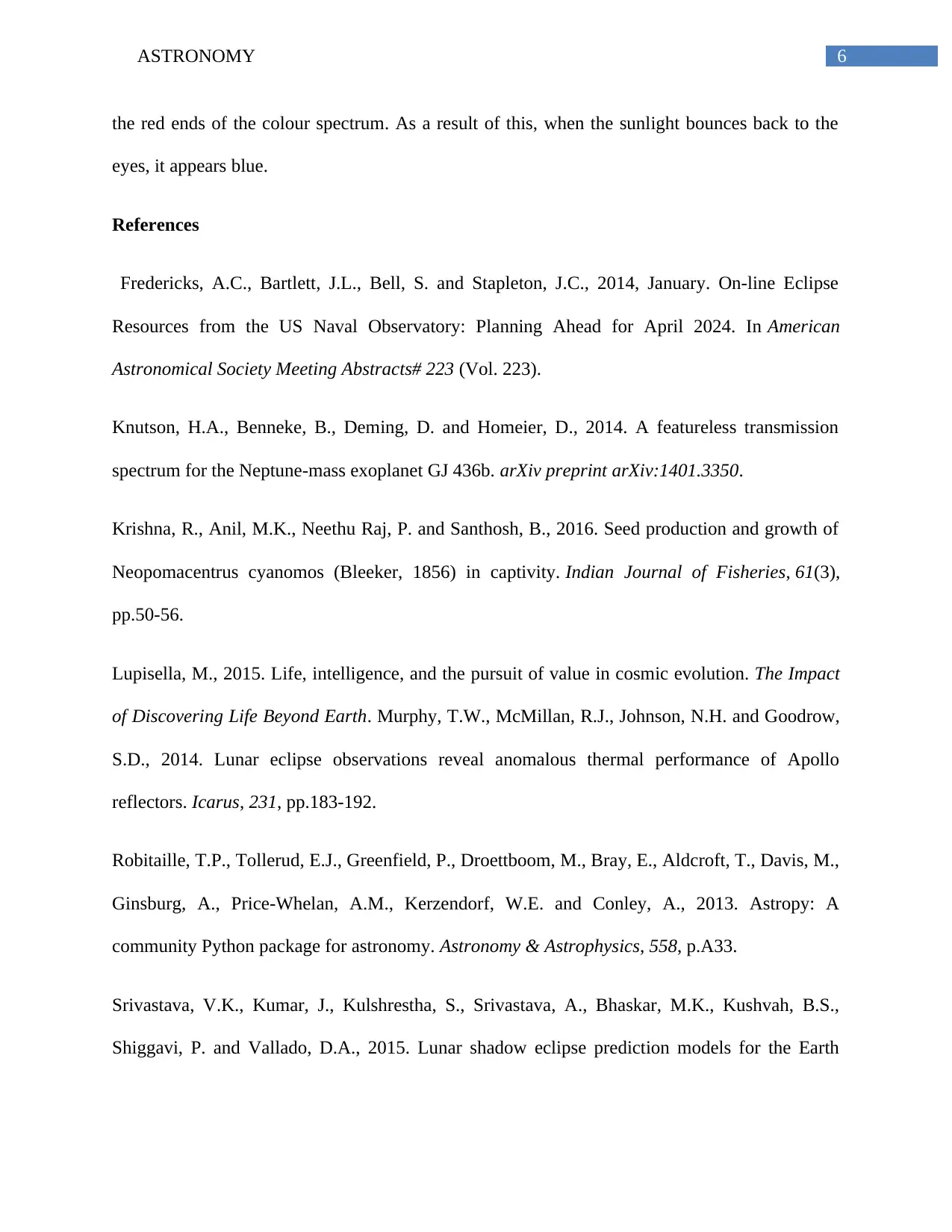
6ASTRONOMY
the red ends of the colour spectrum. As a result of this, when the sunlight bounces back to the
eyes, it appears blue.
References
Fredericks, A.C., Bartlett, J.L., Bell, S. and Stapleton, J.C., 2014, January. On-line Eclipse
Resources from the US Naval Observatory: Planning Ahead for April 2024. In American
Astronomical Society Meeting Abstracts# 223 (Vol. 223).
Knutson, H.A., Benneke, B., Deming, D. and Homeier, D., 2014. A featureless transmission
spectrum for the Neptune-mass exoplanet GJ 436b. arXiv preprint arXiv:1401.3350.
Krishna, R., Anil, M.K., Neethu Raj, P. and Santhosh, B., 2016. Seed production and growth of
Neopomacentrus cyanomos (Bleeker, 1856) in captivity. Indian Journal of Fisheries, 61(3),
pp.50-56.
Lupisella, M., 2015. Life, intelligence, and the pursuit of value in cosmic evolution. The Impact
of Discovering Life Beyond Earth. Murphy, T.W., McMillan, R.J., Johnson, N.H. and Goodrow,
S.D., 2014. Lunar eclipse observations reveal anomalous thermal performance of Apollo
reflectors. Icarus, 231, pp.183-192.
Robitaille, T.P., Tollerud, E.J., Greenfield, P., Droettboom, M., Bray, E., Aldcroft, T., Davis, M.,
Ginsburg, A., Price-Whelan, A.M., Kerzendorf, W.E. and Conley, A., 2013. Astropy: A
community Python package for astronomy. Astronomy & Astrophysics, 558, p.A33.
Srivastava, V.K., Kumar, J., Kulshrestha, S., Srivastava, A., Bhaskar, M.K., Kushvah, B.S.,
Shiggavi, P. and Vallado, D.A., 2015. Lunar shadow eclipse prediction models for the Earth
the red ends of the colour spectrum. As a result of this, when the sunlight bounces back to the
eyes, it appears blue.
References
Fredericks, A.C., Bartlett, J.L., Bell, S. and Stapleton, J.C., 2014, January. On-line Eclipse
Resources from the US Naval Observatory: Planning Ahead for April 2024. In American
Astronomical Society Meeting Abstracts# 223 (Vol. 223).
Knutson, H.A., Benneke, B., Deming, D. and Homeier, D., 2014. A featureless transmission
spectrum for the Neptune-mass exoplanet GJ 436b. arXiv preprint arXiv:1401.3350.
Krishna, R., Anil, M.K., Neethu Raj, P. and Santhosh, B., 2016. Seed production and growth of
Neopomacentrus cyanomos (Bleeker, 1856) in captivity. Indian Journal of Fisheries, 61(3),
pp.50-56.
Lupisella, M., 2015. Life, intelligence, and the pursuit of value in cosmic evolution. The Impact
of Discovering Life Beyond Earth. Murphy, T.W., McMillan, R.J., Johnson, N.H. and Goodrow,
S.D., 2014. Lunar eclipse observations reveal anomalous thermal performance of Apollo
reflectors. Icarus, 231, pp.183-192.
Robitaille, T.P., Tollerud, E.J., Greenfield, P., Droettboom, M., Bray, E., Aldcroft, T., Davis, M.,
Ginsburg, A., Price-Whelan, A.M., Kerzendorf, W.E. and Conley, A., 2013. Astropy: A
community Python package for astronomy. Astronomy & Astrophysics, 558, p.A33.
Srivastava, V.K., Kumar, J., Kulshrestha, S., Srivastava, A., Bhaskar, M.K., Kushvah, B.S.,
Shiggavi, P. and Vallado, D.A., 2015. Lunar shadow eclipse prediction models for the Earth
⊘ This is a preview!⊘
Do you want full access?
Subscribe today to unlock all pages.

Trusted by 1+ million students worldwide

7ASTRONOMY
orbiting spacecraft: Comparison and application to LEO and GEO spacecrafts. Acta
Astronautica, 110, pp.206-213.
orbiting spacecraft: Comparison and application to LEO and GEO spacecrafts. Acta
Astronautica, 110, pp.206-213.
1 out of 7
Your All-in-One AI-Powered Toolkit for Academic Success.
+13062052269
info@desklib.com
Available 24*7 on WhatsApp / Email
![[object Object]](/_next/static/media/star-bottom.7253800d.svg)
Unlock your academic potential
Copyright © 2020–2025 A2Z Services. All Rights Reserved. Developed and managed by ZUCOL.